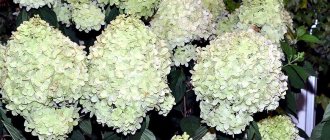Decorative and unpretentious chamomile chrysanthemums can easily decorate any garden. Thanks to its many positive qualities, this plant has become widespread and has been successfully grown for decades in many regions of the country. Moreover, almost all varieties are undemanding and get along well in any weather conditions.
The variety of varieties of chamomile chrysanthemums allows them to be successfully used in landscape design
What are the names of chrysanthemums that look like daisies?
Daisy chrysanthemums belong to the Asteraceae family, which originally appeared in Asian countries and were used as indoor plants. At the end of the 18th century, flowers were brought to Europe, where they gained popularity as a garden crop.
Chamomile-shaped chrysanthemums are presented as perennial shrub plants with umbrella-shaped inflorescences, visually reminiscent of chamomile flowers, which became the reason for their simple name among gardeners. Scientifically, this species is called Chrysanthemum morifolium, which means “sun flower”, “golden flower”. Flowers are also divided into varieties with a specific name, which can have different inflorescence shapes: semi-double and non-double (simple).
What types of asters are there - we study and choose
Adding an article to a new collection
It is impossible to be a florist and not love asters! It’s hard to even imagine a garden without them. They are, if not his queens, then certainly princesses. There is even a type of flower with this name.
And you certainly shouldn’t call asters grandma’s flowers. Now so many of their varieties have been bred that previously they could not even imagine such a variety! Differing in flower shape, height, blooming so that the leaves are not visible. How to navigate through all the diversity of asters?
What do chamomile chrysanthemums look like?
Chamomile chrysanthemums are diverse in appearance and are represented by different varieties, but the flowers have common features:
- stems are thick, erect and leafy;
- leaf blades are large with jagged edges;
- umbrella-shaped inflorescences;
- flowers have reed, marginal, tubular type petals, arranged in one or several rows;
- petiolate, dissected leaves;
- the root system is fibrous;
- Up to 20 inflorescences can be formed on one stem.
All types of chamomile chrysanthemums bloom profusely. The flowering time of those varieties that are intended for cultivation in open ground is usually about ten weeks after the appearance of the first flowers. Indoor species with proper care can bloom all year round.
Attention! Flowers stand for a long time after being cut without losing their external qualities.
What is the difference between chrysanthemum and chamomile?
Chamomile and chamomile chrysanthemum belong to the same Asteraceae family, but regardless of this they have only a visual similarity. Otherwise, these two types are different.
Chrysanthemums and daisies have the following significant differences:
- height and size of the bush - daisies grow no more than 60 cm in height, since chrysanthemums can reach up to 1.5 m;
- color - white petals and a yellow core are considered a classic color, which is precisely characteristic of daisies, while chrysanthemums are represented by a more extensive color palette;
- flower diameter - chamomile flowers are much smaller, equal to no more than 2.5 cm;
- flowering period - daisies are considered summer plants, since their flowering occurs in July and ends in September, while chrysanthemums delight with flowering until late autumn.
The extreme petals of chrysanthemum flowers can be arranged in several rows, unlike chamomile
Pests and diseases
The main diseases that can befall the aster include fusarium, blackleg, rust and jaundice. Most often you can encounter fusarium, which causes wilting. It is impossible to save the crop - it must be removed and burned. An aster infected with blackleg causes the rhizome to rot, the bush turns black and withers. The plant is removed from the soil, which is then treated with potassium permanganate. “Rust” is characterized by swelling and drying of leaves. “Jaundice” is much less common and is mainly carried by pests such as cicadas and aphids. It is manifested by burning out of leaf blades, stopping growth and budding. In this case, spraying with insecticides will help.
Among the pests, the most dangerous are spider mites, meadow bugs, earwigs, aphids and slugs. As a preventive measure, it is necessary to dig up the soil every autumn to remove the remains of annuals. Chemicals such as foundationazole, metaldehyde, karbofos, etc. will help cope with pests.
Varieties of chamomile chrysanthemums
Chamomile chrysanthemums are presented in a wide variety. Thanks to the work of breeders, gardeners can choose the most suitable type of this crop, which will fit perfectly into any landscape design.
Ariel
The Ariel variety is a white bush chamomile chrysanthemum, which is very similar in appearance to the field representative of the Astrov family. The bush reaches only 80 cm in height, the petals are snow-white, the center is golden yellow. The only thing is that the petals are arranged in several rows and the size of the flowers themselves is much larger than an ordinary chamomile - it can be up to 12 cm in diameter.
The variety is an early flowering variety, the first buds begin to bloom in July
Bacardi
The Bacardi variety has non-double flowers, smaller in diameter than the previous type and only about 5 cm. The bush is tall with strong, very flexible stems that are not prone to fractures. The color varies from white to burgundy. Inflorescences consist of 5-8 buds.
Flowers of the Bacardi variety can retain their original appearance for two weeks after cutting.
Evening lights
The Evening Lights variety is a low-growing species, reaching a height of no more than 40 cm. Flowering is abundant, it is characterized by small red buds up to 5-6 cm in diameter with a yellow core.
The Evening Lights variety has an underdeveloped root system
Hebe
The Hebe variety is a late-flowering species. The shrub is medium-sized, up to 50 cm in height. The petals are arranged in a single row, gathered towards a bright yellow core. The flowers have a lilac or crimson hue and are about 7 cm in diameter.
The core of flowers of the Hebe variety is convex
Teddy bear
The Teddy Bear variety has semi-double small flowers up to 4 cm in diameter, with red-orange petals arranged in several rows. The height of the bush is about 55 cm. It blooms later - from October to November. This small chrysanthemum, like a daisy, is called Teddy Bear precisely because of the lush flower, as if made of plush.
The core of the flower in the Teddy Bear variety is hardly noticeable due to the multi-row arrangement of the petals
Overview of aster species and varieties
The types and varieties of aster, a flower that got its name from the star-shaped shape of its petals, are quite diverse. But few people know that the botanical name of many popular forms of this garden plant indicates that it belongs to a completely different genus - callistephus . Real asters - perennial white and colored, double and star-shaped, spherical and with a flat rosette, look noble and discreet, are popular in cutting, border plantings, and ridges.
The species diversity of asters includes agerate, Tatar and Siberian forms, popular alpine, shrub, and European subtypes. With their help, you can easily turn your flower garden into a real riot of colors that lasts all year round. Tall and low varieties of asters can be used in mixed plantings; they are well compatible and harmoniously complement each other in multi-level compositions.
Reproduction methods
Chamomile chrysanthemums, like most cultivated plants, can be propagated in several ways. The most common method is cuttings, and the simplest is dividing the bush. But growing through seeds is a labor-intensive process that takes a lot of time and effort.
Cuttings
Chamomile chrysanthemum cuttings are harvested in the autumn, when the plant is pruned for the winter. Healthy stems up to 7 cm long, which should have 2-3 buds, are chosen as planting material. The finished cuttings are first placed in a growth stimulator, then sent to water or prepared soil. As soon as root branches appear, the seedlings are placed in a cool place until spring. In May, young plants are planted in open ground.
Dividing the bush
To propagate chamomile bush chrysanthemum at home by division, you need to choose a healthy mother plant that is at least two years old. The bush is carefully dug up and its root system is divided into several parts. Each “daughter” plant is immediately planted in a new shaded place.
Attention! Dividing a chamomile chrysanthemum bush is carried out not only for the purpose of reproduction, but also in order to reduce root growth.
Seed method
The seed method is usually used when propagating annual chrysanthemum species. To do this, planting material is prepared after flowering and dried. You can also stratify the seeds to increase their chance of germination.
Planting material is sown in specially prepared nutrient soil. The container is covered with film or glass to create a greenhouse effect. Periodically, the cover is removed for watering, ventilation and condensation removal. Irrigation is carried out using a spray bottle.
Shoots should appear after 14-15 days. Then, after the formation of two full-fledged leaves, the sprout is picked and transplanted into a separate container.
Advice! To increase the chance of seed germination, you can use additional lighting with a UV lamp, as well as fertilize with complex fertilizers at least once every two weeks.
In spring, sprouts can be planted in open ground. If the temperature does not allow it, then it is best to initially transplant the seedling into a greenhouse so that it becomes stronger for growing in the garden.
Roses
Ground cover (creeping) roses are distinguished by their low height - the group arose as a result of the hybridization of rose hips with the climbing rose “Vihura”, which endowed the new plants not only with unique decorative flowers, but also with resistance to low temperatures and diseases.
It takes only 2 years for creeping roses to form a dense carpet, for dwarf varieties not exceeding 45 cm. The varieties deserve special attention:
- Scarlet - double ruby-scarlet flowers open so thickly that they almost hide the glossy leaves underneath. Scarlet does not need annual pruning.
- Amber Garden - captivates with a unique combination of reddish foliage and creamy yellow flowers, collected in clusters of 5-8 pieces. The smell is weaker than other varieties, but it smells like caramel.
- Snow Ballet - snow-white flowers with a diameter of 6–8 cm have 25 petals, which gives them aristocratic splendor. In rainy summers, some flowers may be damaged.
Growing poppies on your own site: what types of flowers can be planted in a flower bed
Seedlings of ground cover roses can be purchased in the fall and stored until spring in the cellar at +1 °C, buried in damp sand.
Planting and caring for chamomile chrysanthemums
Chrysanthemums, similar to daisies, which have an identical name among gardeners, do not have specific planting and care features. The young plant is planted in open ground in compliance with the timing and certain growing conditions.
At home, they usually choose propagation by cuttings or dividing the bush.
Terms and conditions of cultivation
Chamomile chrysanthemums are usually planted in the spring. In different regions, planting time may vary from mid-May to early June. If you need to plant seedlings in open ground in the fall, you should choose a time at least a month before the onset of the first frost.
The location for the future chrysanthemum should be sunny and slightly elevated to prevent moisture stagnation. The holes are prepared small, about 30 cm in depth and in diameter. Drainage material is placed at the bottom. If it is necessary to plant several bushes at once, then they are placed at a distance of 20-30 cm from each other (for tall varieties it is recommended to maintain at least 40-50 cm).
How to plant correctly
The algorithm for planting chamomile chrysanthemum is quite simple and consists of the following steps:
- Preparing the hole.
- When the hole is ready and the drainage layer has been completed, planting begins. A little fertile soil mixture is poured over the drainage, then the seedling is placed, straightening the roots well. Sprinkle with substrate, tamp lightly and water.
- On the day of planting, it is recommended to fertilize the young plant for better rooting.
- To speed up flowering, at the time of planting, the first pinching of the chamomile chrysanthemum is performed, carefully removing the growth point of the shoots.
Aftercare
Caring for chamomile chrysanthemums involves watering, fertilizing and preparing for winter.
Watering is carried out periodically when the upper layers of the soil dry out. As a rule, watering in hot weather is carried out three times a week strictly at the root of the plant. After moistening the soil, it is recommended to fertilize with a potassium-phosphorus complex.
Attention! During flowering, watering must be reduced to 1-2 times a week.
2-3 weeks after planting a chamomile chrysanthemum seedling in open ground, you can make a second pinching, removing the tops with 2-3 nodes from new shoots.
As soon as the leaves begin to wither and dry out in the fall, this means that the plant is ready to rest. Therefore, it is necessary to start preparing chrysanthemums for winter. To do this, the bushes are pruned, leaving the stems about 10 cm. For the southern regions, it is enough to mulch the bush, but in the northern regions it is recommended to cover it with sawdust or spruce branches.
Iberis
The most common plant is the annual Iberis umbellata. The branches of its spreading bushes up to 30–40 cm are not covered with fluff, like many other varieties.
In order for Iberis to bloom from May to September, its seeds are sown directly into the ground in April 2 times with an interval of 2-3 weeks. Also, for a full-fledged decorative appearance, Iberis needs:
- in moderate application of fertilizers - an excess leads to the growth of greenery;
- no transplants - if the taproot is damaged, the plant dies;
- loamy soil, well permeable to air and water;
- systematic removal of flowering shoots to form new buds.
Designers advise combining Iberis with evergreens, such as cypress and juniper. Iberis is also harmonious with large bells, tulips, as well as with drought-resistant ground covers such as sedum, creeping tenacious and creeping phlox.
What plants are combined with?
Chamomile chrysanthemums are usually used in landscape design for group planting together with other low-growing crops. Flowering bushes also look great when planted in the border.
Low-growing varieties are excellent for composition with small coniferous and deciduous trees, and they also harmonize well with marigolds, coleus, balsam and zinnia. In combination with asters and hydrangeas, chamomile chrysanthemums can be planted against the backdrop of evergreen bushes.
Chamomile chrysanthemums are often used to create mixborders
Meet the annual aster
These are the same asters that you are used to seeing in bouquets - with large, hairy flowers on a long stem.
Annual asters are not asters at all, but plants of the genus Callistephus.
Annual asters sprout well from seeds sown in the soil. But it is possible to admire the flowers only closer to September. But early varieties of asters grown from seedlings bloom in early July.
Annual asters should from time to time (at least once every 2 years, and preferably annually) change their “registration” on the site.
They do not like to be planted in the same place that was previously occupied by gladioli, tulips or carnations. But they alternate perfectly with marigolds or calendula.











